Butterflies
Recording butterflies in Caithness.
What to record;
Species; the date the record was observed; the location (name from OS map if possible); Grid reference 6 figure preferably.
Additional information also of help is habitat, number, life stage (caterpillar, eggs, adult) food plant.
If you have an image of the butterfly especially for more uncommon species then that is a great help.
Below is a list of butterflies recorded in highland with some background information.
Information sources
- Atlas of Butterflies in Highland and Moray (1980-2007) Barbour, Moran, Mainwood and Slater .
- NBN Atlas Scotland
Louded Yellow , Colias croceus
Highland Status; migratory, rare and irregular in north Scotland.
Records in Caithness are from the 1992 influx when recorded from coastal areas and links habitat e.g. Dunnet Bay/ Sinclair Bay.
Habitat; Very wide ranging in open country, occasionally found in gardens
Flight period; Influx in May. Second generation bred locally in August September.
Larval food plant; Bird`s foot trefoil and clovers.
Large White; Cabbage white, Pieris brassicae
Highland Status; widespread in the north through strong migratory habit with a bias towards human habitation
Records; Under-recorded in Caithness
Habitat; gardens and cultivated crops
Flight period; late May to early September
Larval food plant; Brassica and other cultivated species of cultivated Cruciferae.
Small white; Pieris rapae
Highland status; native/ common immigrant, occasional in the far north
Records; under recorded in Caithness records mostly coastal
Habitat; gardens, flowery waysides
Flight period; late April to mid September.
Larval food plant cultivated plants of the cabbage family
Green-veined white; Pieris napae
Highland status; common and widespread native
Records; well recorded in Caithness apart from peat land and hills
Habitat, damp pasture, stream and ditch sides open forest rides
Flight period; late April to early autumn
Larval food plant; cuckoo flower (Cardamine pratensis)and wild crucifers.
Orange tip Anthocharis cardamines
Highland status; spread north and west in the highlands from the 1980s and is probably still expanding.
Records; 2 in Caithness NE of loch Calder and ND26, 10 km square.
Habitat; damp meadows and streamsides where cuckoo flower is abundant
Flight period end April to mid June
Food plant ; cuckoo flower Cardamine pratensis
Green hairstreak; one record from ND 23 10 km square
Highland status; widespread in the west and in central Spey Valley, upland Easter Ross and east Inverness shire. Stable
Records; none in Caithness
Habitat; blueberry rich moorland and open woodland; also associated with gorse scrub
Flight period; end April to mid June
Larval food plant; blueberry, gorse and cross-leaved heath
Small Copper, Lycaena phlaeas
Highland status; native species , uncommon in the north
Records; occasional in Caithness, Sandside bay , Dunnet Bay and Berriedale braes.
Habitat; waste ground and rough grassland where larval plants grow, banks, dunes
Flight period; mid May to September
Larval food plant; sorrels
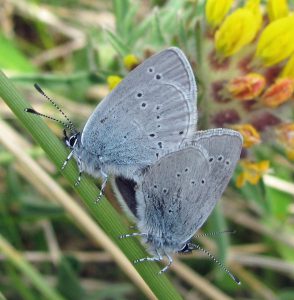
small blue mating
Small Blue, Cupido minimus
Highland status; priority species colonies centred around Moray Firth and North Caithness
Records; Dunnet Dunes to Scrabster
Habitat; focuses on presence of kidney vetch and shelter, coastal dunes, gravel areas and old quarry sites.
Flight period; late May Early June
Larval food plant; Kidney Vetch
See also the CBG Project to expand small blue habitat.
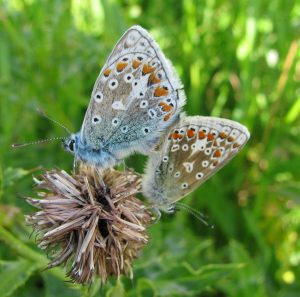
Common Blue (Mating)
Common Blue; Polyommatus icarus
Highland status; native and common
Records; widespread, though thought to be declining
Habitat; grassy areas where birds foot trefoil grows
Flight period; mid June to late August
Larval food plant; birds foot trefoil (Lotus corniculatus)
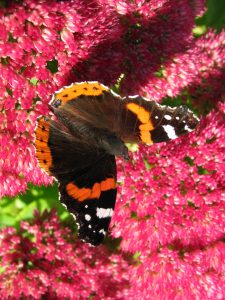
Red Admiral
Red Admiral, Vanessa atalanta
Highland status: largely migrant though now proved to have bred and hibernated through the winter.
Records. Caithness records are coastal and lower altitudes.
Habitat; Widespread in open country and forest rides. Common in gardens on buddleia, iceplant and cotoneaster
Flight period; migrant in late May/June breeding to produce off spring, flying in late summer to autumn. Any spotted in January/ February will have hibernated in a mild winter.
Larval foodplant; nettles
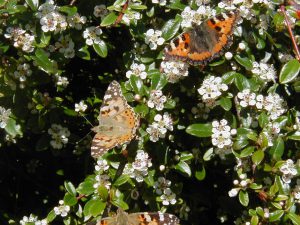
Painted Lady + Small Tortoiseshell
Painted lady; Cynthia cardui
Highland status. Migrant, less common than red admiral
Records, numbers vary annually but seen most years, and thought to be more abundant
Habitat; open country gardens, flower rich areas of rough pasture or waste ground especially where thistle species grow.
Flight period; main influx in June, with local bred offspring in autumn.
Larval foodplant; Thistle (Cirsium vulgare and Cirsium palustre)
Small tortoiseshell, Aglais urticae
Highland status and population trends; native species, common, fluctuates greatly with recent trends going downwards
Records; widespread
Habitat; found in many habitats up to hilltops
Flight period after hibernation; April to June. Offspring, late July to September. Occasional adults seen flying early in the year on exceptionally warm days .
Larval foodplant. Common nettle Urtica dioica
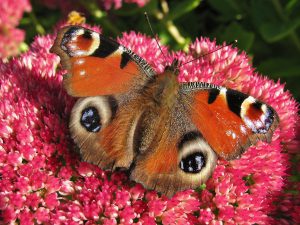
Peacock
Peacock, Inachis io
Highland status; Seen as a vagrant until 2002. September of that year there was a large influx to Eastern Inverness and Morayshire. Since then it has extended its range throughout Highland including Caithness.
Records Increasing numbers of records
Habitat; flower rich areas, gardens.
Flight period end of March to early June and early August to October
Larval food plant; common nettle
Camberwell beauty, Nymphalis antiopa
Highland status occasional migrant, doesn’t breed in UK
Records; 1 in Caithness, Reay area.
Habitat; wide ranging in gardens to feed on flowers and rotting fruit
Flight period; immigrants appear in autumn. Some overwinter to produce records in April/May
Larval foodplant; sallow and poplar.
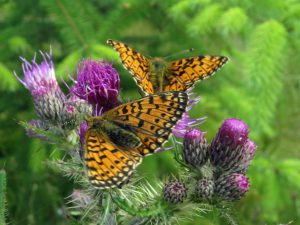
small pearl bordered fritillary
Small pearl bordered fritillary (Borolia silene) priority species
Highland status and trends; widespread and locally abundant, appears to be expanding
Records; Caithness colonies; Broubster forest, Langwell Strath and Berriedale forest, Spittal area and N.E. of Loch Ruard.
Habitat damp grassland where common dog and marsh violet occur
Flight period end of May late July into august
Larval foodplant; common dog and marsh violet
Pearl bordered fritillary (Boloria euphosyn) priority species. Regarded as nationally threatened
Highland status and trends. It appears to be declining in Highland with fewer confirmed sites.
Records. One Caithness record in the Berriedale area.
Habitat. Open base rich woodlands with abundant dog violet(Viola riviniana).
Flight period; early May to mid- June
Larval food plant; Dog Violet (Viola riviniana)
Dark Green Fritillary (Argynnis aglaja)
Highland status and trends; native species, widespread.
Records; probably under recorded in Caithness. Mostly coastal records
Habitat; Flower rich forest rides and dune`s grassland and moorland.
Flight period; late June to end August
Larval food plant violets riviniana and palustris
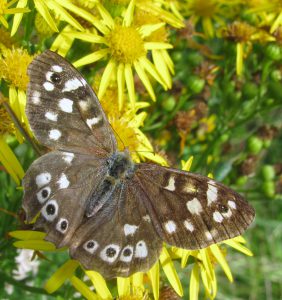
Speckled Wood
Speckled Wood (Pararge aegeria)
Highland status; native, colonised Moray, Easter Ross into Sutherland and over the last 40 years
Records; Reached Caithness after 2000 .and now present in many woodlands and plantations such as Dunnet forest and Achvarasdal woodland
Habitat;conifer and broadleaved woodland, well developed scrub and mature gardens. The butterfly is very shade tolerant.
Flight period; late April to early October
Larval foodplant; grasses including False Brome, couch grass and cock`s foot
Scotch Argus (Erebia aethiops)
Highland status;widespread in Highland apart from Caithness and Sutherland. Population stable and appears to be increasing in West Sutherland
Records; One record in Caithness, East Caithness coast ND13
Habitat; sheltered woodland rides and clearings. Open coastal slopes and upland rough pasture.
Flight period late July –early Sept
Larval food plant purple moor grass
Grayling (Hipparchia semele)
Highland status; Native species, local. General decline,especially in the west.
Records; one pre 1996 record for north Caithness
Habitat; coastal cliffs, shingles and dunes
Flight period ; end of June end of August
Larval foodplants; various grasses.
Meadow Brown (Maniola jurtina)
Highland status and trends; Native species, common and widespread. Fluctuating population, but stable.
Records; frequent in Caithness though absent in high places
Habitat; open grassland, coastal dunes, woodland clearings and rough pasture.
Flight period; late June end of August
Larval food plants, various grasses.
Ringlet (Aphantopus hyperantus)
Highland status and trends; this butterfly has spread from its former range limit in Aberdeenshire. It has been recorded since 1995 in Morayshire and Speyside where it is now common
Records; not yet recorded in Caithness
Habitat; damp coarse grassland where there is shelter, forest rides and edges
Flight period; late June beginning of August
Larval food plant; various grasses
Small heath (Coenonympha pamphilus); priority species
Highland status; widespread species of grassland from coast to 500 metres.Thought to be declining in eastern Highland.
Records; occasional records in Caithness. Dunnet head Dunnet Bay also a concentration around Berriedale/Langwell strath
Habitat; coastal dune, dry grassland, woodland clearings and moorland edge.
Flight period; May to early August
Larval food plant; grasses particularly fescues
Large Heath (Ceonympha tullia)
Highland status; occurring widely in acid boggy habitats with strong populations in the peatlands of Caithness and Sutherland
Records; well recorded throughout Caithness
Habitat; boggy moorland up to 600 metres
Flight period; mid June to early August
Larval foodplant; cotton grass Eriophorum vaginatum